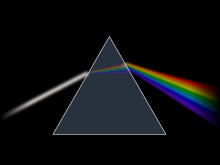Rainbow gravity theory

Rainbow Gravity theory (sometimes called "Gravity's Rainbow"[1]) is a proposed theory which suggests that the universe has no beginning and stretches back in time infinitely with no Big Bang, or otherwise definitive beginning, predicated on the theoretical axiom that different waves of light experience gravity differently. The theory was first put forth at the beginning of the 21st century and possesses the potential to bridge the gap between general relativity and quantum mechanics.[2] The theory is named as such due its postulation that gravity can separate light into its respective wavelengths, forming a rainbow similar to that of a prism.[3] Scientists are currently attempting to detect Rainbow Gravity using the Large Hadron Collider.[4]
Background
Rainbow Gravity Theory's origin is largely the product of the disparity between general relativity and quantum mechanics. More specifically, "locality," or the concept of cause and effect that drives the principles of general relativity, is mathematically irreconcilable with quantum mechanics.[5] This issue is due to incompatible functions between the two fields; in particular, the fields apply radically different mathematical approaches in describing the concept of curvature in four-dimensional space-time.[5] Historically, this mathematical split begins with the disparity between Einstein's theories of relativity, which saw physics through the lens of causality, and classical physics, which interpreted the structure of space-time to be random and inherent.[6]
Theory
In 2003, the theory was developed in opposition to the dominant Big-Bang Theory as a method of reconciling the conflicting mathematics of the different fields of physics.[2] It postulates that the different wavelengths of light, being of different electromagnetic energies, are curved, and ultimately separated, by gravity as they travel through the universe.[7] This phenomenon would be imperceptible in areas of relatively low gravity, such as Earth, but would be significant in areas of extremely high gravity, such as a black hole.[7] If true, this theory disproves the Big-Bang theory, which calls for all wavelengths of light to be impacted by gravity to the same extent.[2]
Implications About Space and Time
The prevailing notion about cosmic change is that the universe is expanding at a constantly accelerating rate; moreover, it is understood that as one traces the universe's history backwards one finds that it was, at one point, far denser. If true, the Rainbow gravity theory prohibits a singularity such as that which is postulated in the Big Bang. This indicates that, when viewed in reverse, the universe slowly approaches a point of terminal density without ever reaching it, implying that the universe does not possess a point of origin.[7]
Criticism
There are stringent constraints on energy-dependent speed-of-light scenarios.[8] Based on these, Sabine Hossenfelder has strongly criticised the rainbow gravity concept, stating that "It is neither a theory nor a model, it is just an idea that, despite more than a decade of work, never developed into a proper model. Rainbow gravity has not been shown to be compatible with the standard model. There is no known quantization of this approach and one cannot describe interactions in this framework at all. Moreover, it is known to lead to non-localities with are ruled out already. For what I am concerned, no papers should get published on the topic until these issues have been resolved."[9]
See also
References
- ^ see, e.g., Zyga, Lisa (January 15, 2015). "Black holes do not exist where space and time do not exist, says new theory". phys.org. Retrieved March 28, 2015.
- ^ a b c Clara Moskowitz (9 Dec 2013). "In a "Rainbow" Universe Time May Have No Beginning". Scientific American.
- ^ Greg Kestin (13 Dec 2013). "Universe May Have Been Around Since Forever, According to Rainbow Gravity Theory". NovaNext.
- ^ Sarah Knapton (23 Mar 2015). "Big Bang theory could be debunked by Large Hadron Collider". The Telegraph.
- ^ a b Slavnov, D. A. (2012-07-06). "Possibility of reconciling quantum mechanics with general relativity theory". Theoretical and Mathematical Physics. 171 (3): 848–861. doi:10.1007/s11232-012-0080-z. ISSN 0040-5779.
- ^ O’Hara, Paul (2005-09-01). "Quantum Mechanics and the Metrics of General Relativity". Foundations of Physics. 35 (9): 1563–1584. doi:10.1007/s10701-005-6483-z. ISSN 0015-9018.
- ^ a b c "The "rainbow gravity" theory in layman's terms - Quora". www.quora.com. Retrieved 2015-10-12.
- ^ Hossenfelder, Sabine (9 April 2010). "Bounds on an Energy-Dependent and Observer-Independent Speed of Light from Violations of Locality". Phys. Rev. Lett. 104 (14). doi:10.1103/PhysRevLett.104.140402.
- ^ Sabine Hossenfelder (March 25, 2015). "No, the LHC will not make contact with parallel universes". Backreaction. Retrieved 17 October 2015.
